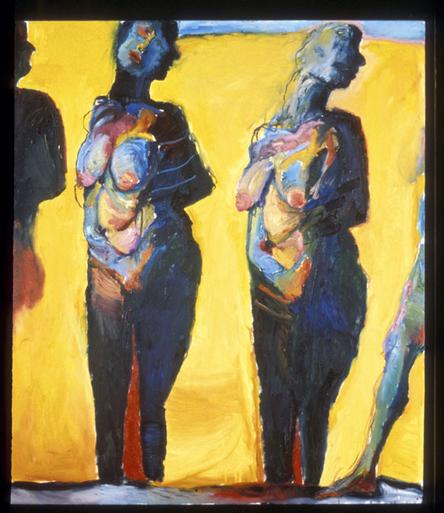
The bodies ache with color. They arch, contort and strain—even though stationary. Motion and vibration charge each canvas. These are intense images: some viewers report seeing violence or horror. Others describe feelings of joy or amazement.
But no matter which end of the spectrum, there’s bound to be a reaction. Such are the paintings and drawings to be found in “The Body Electric: New American Expressionism” at Art Sites in Riverhead. All of the art in the sprawling gallery was made by Elizabeth Silver, encompassing a little more than a decade of figurative expressionism. Each sings with color and is filled with energy.
Ms. Silver’s art is linked to the expressionist painters of Germany, Austria and Northern Europe in the pre-World War II era. Her predecessors include Wassily Kandinsky (1866-1944), Edvard Munch (1863-1944), Ernst Ludwig Kirchner (1880-1938), Egon Schiele (1890-1918), Otto Dix (1891-1969) and Emil Nolde (1867-1956), artists who used expressionism to portray the turmoil of their time.
Unlike those artists, Ms. Silver doesn’t bring current events into her art. Like the early expressionists, she channels the energy she feels, the colors she sees, and the emotions that come from being in the moment of making art.
She always works from live models and paints every single day. She strives to have new models every time so every experience is new and unique. Her works are rendered quickly and she doesn’t plan what’s going to happen. This sometimes means that a drawing ends up using four sheets of paper combined instead of a single sheet.
“It’s the line,” Ms. Silver said in a recent interview. “I love the motion of making marks and lines. Nothing is planned. I work very fast and I always draw the first thing I’m drawn toward. It just grows from there.”
The vivid colors in Ms. Silver’s work are a reflection of what she actually sees, she said. Gazing at bodies rendered in purples, blues, oranges, pinks, yellows and other colors, it becomes apparent Ms. Silver sees the world differently than most. To accentuate colors found reflected in nude bodies, she works in artificial light with darkened windows.
She told a story of a time when she was helping to monitor a painting class at the Art Students League. A student was painting a realistic still life. When asked for color advice, Ms. Silver recommended adding blue she saw in the tablecloth. Later on, the instructor admonished the student for painting a color that wasn’t there and the hue was removed.
“I didn’t say anything because it wasn’t my class,” Ms. Silver said. “It was apparent that I see color differently than others.”
Colors are not confined to the figures she creates. The entire canvas is fair game. For Ms. Silver, there is no negative space or edge where the figure separates from the space it physically occupies. The painting or drawing is an integrated whole with all colors commanding the eye with equal power and depth.
Despite depicting figures, the paintings and drawings are not portraits, she said. The models are a jumping-off point to make art. The faces or bodies are something everyone can identify with and provide access to the work, she said.
Oftentimes, different poses—sketched with charcoal—combine to make one painting with the illusion of multiple models. Other works contain a sole figure or face. Even these cannot be considered portraits because they start with one feature that catches Ms. Silver’s imagination and take off from there. It could be kinky hair, a roll of flesh, protruding teeth, the bend of a knee or long legs that don’t want to be contained on a single sheet of paper.
“I paint what I see and whatever I see, I push it until it seems right,” she said.
None of her work is titled because her art springs from the experience of making it, not from a theme or idea that’s explored.
“Attaching words when the experience is finished always feels false, as if I’m pasting them on without their really adhering,” she explains in her artist statement. “My work is to be felt rather than read.”
Ms. Silver’s connection with the pre-war painters is obvious to people living in Europe, and Germans seem to implicitly understand her work, she said. Positive reviews, sales and multiple solo shows in Germany enable her to measure her fan base there.
“They just get it there,” Ms. Silver said. “Expressionism started there and they recognize that’s what my work is about. It’s figurative expressionism because I work from the figure.”
Ms. Silver has had two solo shows in Munich and one in Berlin. In the United States, solo shows have been held in Manhattan and Connecticut. Her private collectors live in Germany, England, Spain, France, Canada and Brazil.
She has participated in group shows at the Art Students League’s Invitational, the juried show at the Salmagundi Club in Manhattan and at galleries in Washington, D.C., New Jersey, Ohio, and Connecticut. Her work has been exhibited at the Katonah Museum, the Hudson River Museum and the Neuberger Museum, all in New York State.
She and her husband, Stuart, have lived in East Hampton and currently own a home in West Hampton Dunes. They live most of the year in Scarsdale. Ms. Silver’s studio is in Manhattan.
When each day begins, it’s about making art, and the energy that comes from line, color and connecting to the emotions that turn movements by the hand into art.
“I only live in the moment,” Ms. Silver said. “For me, it’s always, ‘Why not?’ I work from energy. It’s so much fun that I can’t wait to get back in my studio to draw or paint some more.”
Elizabeth Silver’s “The Body Electric: New American Expressionism” remains on view through September 14 at Art Sites, 651 West Main Street, Riverhead. The gallery is open Thursday through Sunday from noon to 5 p.m. and by appointment. For information, visit www.artsitesgallery.com or call 631-591-2401.